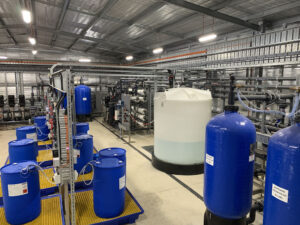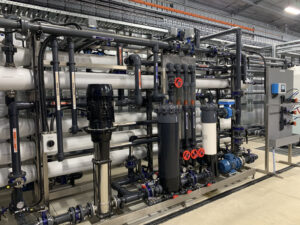
Water security in the Australian Garden, Royal Botanic Gardens Cranbourne
By Trent Loane and Mitchell Burns
The Australian Garden is an inspiring and immersive display of Australian flora, landscapes, art, and architecture. The garden places a focus on sustainable horticultural practices and the conservation of south-east Australian flora. Set across 15ha, the Australian Garden follows a metaphorical journey of water from the arid inland landscapes of central Australia, along dry riverbeds and down mighty rivers, to the coastal fringes of the continent.
Prior to 2021, the Australian Garden and nursery production areas relied on potable water for irrigation, with an annual consumption of approximately 30ML (megalitres) per annum. This practice represented a significant disconnect between the sustainable interpretive theme of the Garden and the expectation of visitors that irrigation is from an appropriate and sustainable water source.
With the support of a State Government grant a project was developed to deliver recycled water to the Gardens from the Eastern Treatment Plant. Class A recycled water is successfully utilised in golf courses, sporting facilities, public parks and gardens, housing estates, and other landscapes that are often comprised of ‘turf and trees’. However, given the complex landscapes and unique requirements presented by living collections within the Australian Garden, and a desire to display Australian plants in peak condition as high-quality horticultural displays, it was deemed essential to ‘treat’ the feed water from the Eastern Treatment Plant through an on-site reverse osmosis water treatment plant. Of particular concern was the risk to the significant number of Proteaceae within the collections and their potential sensitivity to phosphorus and other high nutrient loads that can be present in recycled water.

The raw feed water first enters the Gardens from the Eastern Treatment Plant into a holding tank, and then undergoes secondary treatment comprising media (sand) filtration to remove solids and organic particles prior to reverse osmosis, calcite filtration to balance pH, and transfer to final storage. A critical part of the process is to then blend a pre-determined amount of ‘raw’ water back in to achieve desired nutrient levels.
The treated water is then used to irrigate the Australian Garden and nursery facilities through a computer controlled, reticulated irrigation system comprising a network of 412 distinct solenoid-controlled stations that are programmed using the Penman-Monteith evapotranspiration method, in conjunction with real-time data inputs from an onsite weather station.
The project went through an initial planning phase in 2017-19, with construction completed and a commissioning period over summer 2021/22. Extensive testing was carried out both prior to, and during, operation to determine maximum irrigation requirements during peak summer flows, in addition to ongoing monitoring of nutrient levels, salts, and organic content of the incoming and outgoing treated water.

The plant is designed to be fully automated and can be remotely operated, however human input is required to monitor readings, alarms, and initiate cleaning and maintenance cycles. This provided the gardens with the opportunity to employ a full-time horticulturist with specialist skills in irrigation, soil, and water chemistry. A critical part of this role is an understanding of the specific cultural requirements of a diverse range of Australian native plants and their water requirements, soil types, and rainfall patterns, in addition to understanding the specific site conditions locally at the Australian Garden here in Cranbourne.
Summer 2022/23 saw the plant in full operation through the peak demand period for the first time, with over 19 megalitres of treated recycled water being delivered to the gardens. There will be further periods of ongoing adjustment and calibration of the system to optimise performance with the opportunity to track trends in water quality both in and out of the plant. In addition to this, a program of ongoing monitoring of soil moisture and chemical analysis parameters, and plant health measurements, will ultimately lead to a deep understanding of how our water use affects plant growth across a wide range of species and landscapes.
The ability to secure a reliable and sustainable long-term source of irrigation water for the Cranbourne Gardens has been instrumental in achieving our sustainability goals. Responsible and sustainable water use recognises that water is a most precious resource, which will only become more precious and scarce both now and into a hotter and drier future climate.
Trent Loane
Team Leader Horticulture
Royal Botanic Gardens Cranbourne
Trent.Loane@rbg.vic.gov.au
Mitchell Burns
Horticulturist Irrigation
Main photo: The Water Treatment Plant holding and irrigation tanks (images supplied by Royal Botanic Gardens, Cranbourne)
